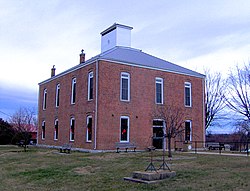2020 census
As of the 2020 census, the county had a population of 6,168 and 1,545 families residing in the county. [15] The median age was 46.9 years; 21.6% of residents were under the age of 18 and 23.5% were 65 years of age or older. For every 100 females there were 97.7 males, and for every 100 females age 18 and over there were 98.0 males age 18 and over. [15]
The racial makeup of the county was 95.5% White, 0.4% Black or African American, 0.1% American Indian and Alaska Native, 0.2% Asian, <0.1% Native Hawaiian and Pacific Islander, 0.2% from some other race, and 3.7% from two or more races. Hispanic or Latino residents of any race comprised 1.3% of the population. [16]
<0.1% of residents lived in urban areas, while 100.0% lived in rural areas. [17]
There were 2,459 households in the county, of which 27.3% had children under the age of 18 living in them. Of all households, 52.3% were married-couple households, 18.2% were households with a male householder and no spouse or partner present, and 24.2% were households with a female householder and no spouse or partner present. About 27.6% of all households were made up of individuals and 14.9% had someone living alone who was 65 years of age or older. [15]
There were 2,901 housing units, of which 15.2% were vacant. Among occupied housing units, 83.3% were owner-occupied and 16.7% were renter-occupied. The homeowner vacancy rate was 2.3% and the rental vacancy rate was 8.4%. [15]
2010 census
As of the 2010 census, [18] there were 5,548 people and 2,096 households in the county. The population density was 20.3 people per square mile (7.8 people/km2). There were 2,673 housing units at an average density of 9.8 units per square mile (3.8/km2). The racial makeup of the county was 97.5% White, 0.7% Black or African American, 0.3% Native American, 0.2% Asian, and 0.9% from two or more races. 0.9% of the population were Hispanic or Latino of any race.
There were 2,096 households, out of which 29.3% had children under the age of 18 living with them, 54.9% were married couples living together, 11.7% had a female householder with no husband present, and 28.0% were non-families. 24.3% of all households were made up of individuals, while 30.6% had someone living alone who was 65 years of age or older. The average household size was 2.43. 82.6% of occupied housing units were owner-occupied, meaning that 17.4% were renter-occupied.
In the county, the population was spread out, with 23.2% up to the age of 19, 8.8% from 20 to 29, 12.4% from 30 to 39, 13.4% from 40 to 49, 16.8% from 50 to 59, 14.7% from 60 to 69, and 10.7% who were 70 years of age or older. The median age was 44.5 years. Women make up 50.2% of the population.
The median income for a household in the county was $29,087. The per capita income for the county was $17,160. 24.6% of the population were below the poverty line.





